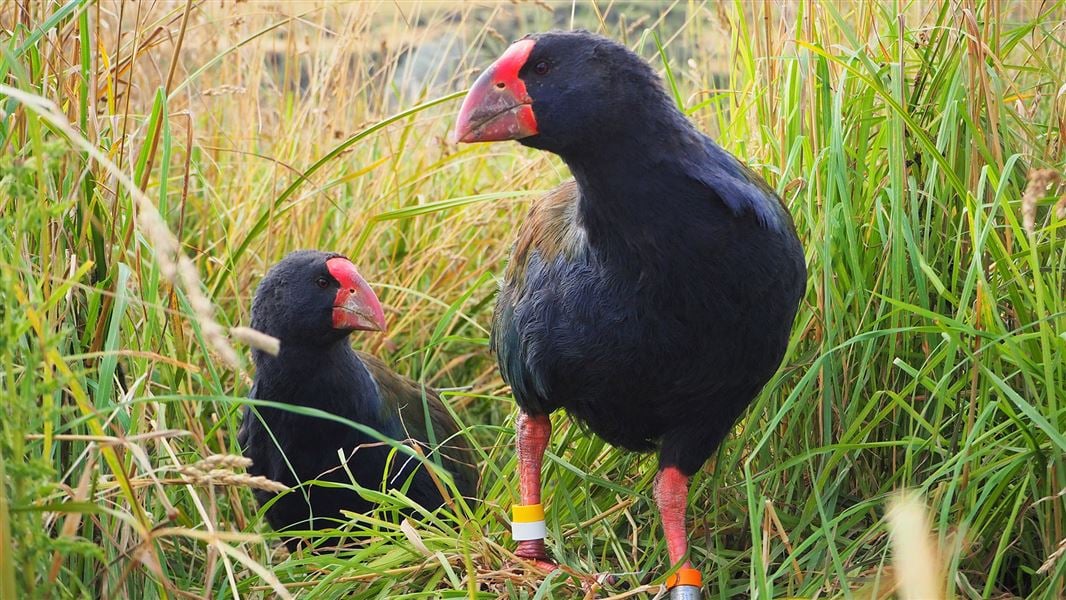Archived content: This media release was accurate on the date of publication.
Date: 18 March 2021
The takahē in Kahurangi National Park are the first to live wild outside of the takahē homeland in Fiordland’s Murchison Mountains in more than a century. The Department of Conservation first released takahē in the park in March 2018 in a milestone step towards the Takahē Recovery Programme’s goal of establishing new wild populations within their former range.
DOC with Ngāi Tahu and Takahē Recovery Programme partner Fulton Hogan released another 29 takahē in the Murchison Mountains last month.
The takahē territory in this area is becoming full and DOC is actively looking for new wild sites for takahē with suitable habitat and the low predator numbers needed for populations to successfully establish.
The 15 takahē released in Kahurangi National Park yesterday (Wednesday 17 March) travelled on Air New Zealand flights from Invercargill to Nelson as part of the airline’s partnership with DOC which has seen it transport around 4,000 threatened species and conservation dogs since 2012.
DOC released 30 takahē in Kahurangi in 2018 and two takahē were hatched and raised there. In the first two years only one of the released takahē died, from natural causes. Then last year the population had a significant setback with 11 of the takahē dying, some also due to natural causes.
DOC’s Takahē Recovery Programme Operations Manager Deidre Vercoe says it was a tough year for the Kahurangi takahē in 2020 and it was disappointing to lose 11 birds.
“Today’s takahē release increases the Gouland Downs takahē population to around 34 birds, enabling us to better evaluate the suitability of the area for sustaining a takahē population.
“The takahē that died from natural causes had low body weights, suggesting they weren’t getting enough food during winter. They were older birds that may have struggled to adapt to a new environment. The 15 birds we’ve continued to monitor are younger and were a healthy weight when checked in September.
“The 15 takahē joining the population are between 1 and 2 years’ old and, being younger, may adjust more readily to the new wild home.
“It’s challenging establishing new wild populations of a native species but ultimately the conservation goal is to return them to living naturally in the wild. What we learn from monitoring the wild takahē informs our selection of other sites for takahē and how we establish and manage wild populations.”
The Takahē Recovery Team is continuing research into measures to reduce 1080 risk to takahē after three of the takahē deaths were due to 1080 following an aerial predator control operation.
No rats or stoats were detected in monitoring following the operation. This has helped protect threatened species, including great spotted kiwi/roroa, kea and whio, at risk from increased rat and stoat numbers due to heavy beech seeding. Further aerial predator control is not expected to be needed in the area for several years.
Background information
- DOC’s Takahē Recovery Programme with Ngāi Tahu and national partner Fulton Hogan has developed a successful blueprint for securing takahē from extinction. Takahē numbers have been growing by around 10% a year since 2015 to now number nearly 450. More than half are across 18 sanctuary sites and with them safe and productive, takahē recovery can now push towards the goal of multiple self-sustaining wild populations.
- Fulton Hogan joined DOC as a national partner to the Takahē Recovery Programme in July 2016. Its support has enabled the recovery programme to grow its work.
- The New Zealand Nature Fund has a long-standing association with the programme and joined the DOC and Fulton Hogan partnership in July 2016, providing administration and advocacy support.
- The Murchison Mountains takahē area has an extensive trapping network but its population loses an average of 15% of adults from predation when stoat numbers rise following beech and tussock seeding. Chick and juvenile deaths are likely to be even higher. This suggests trapping alone does not sufficiently protect takahē in beech forest and tussock environments.
Contact
For media enquiries contact:
Email: media@doc.govt.nz
